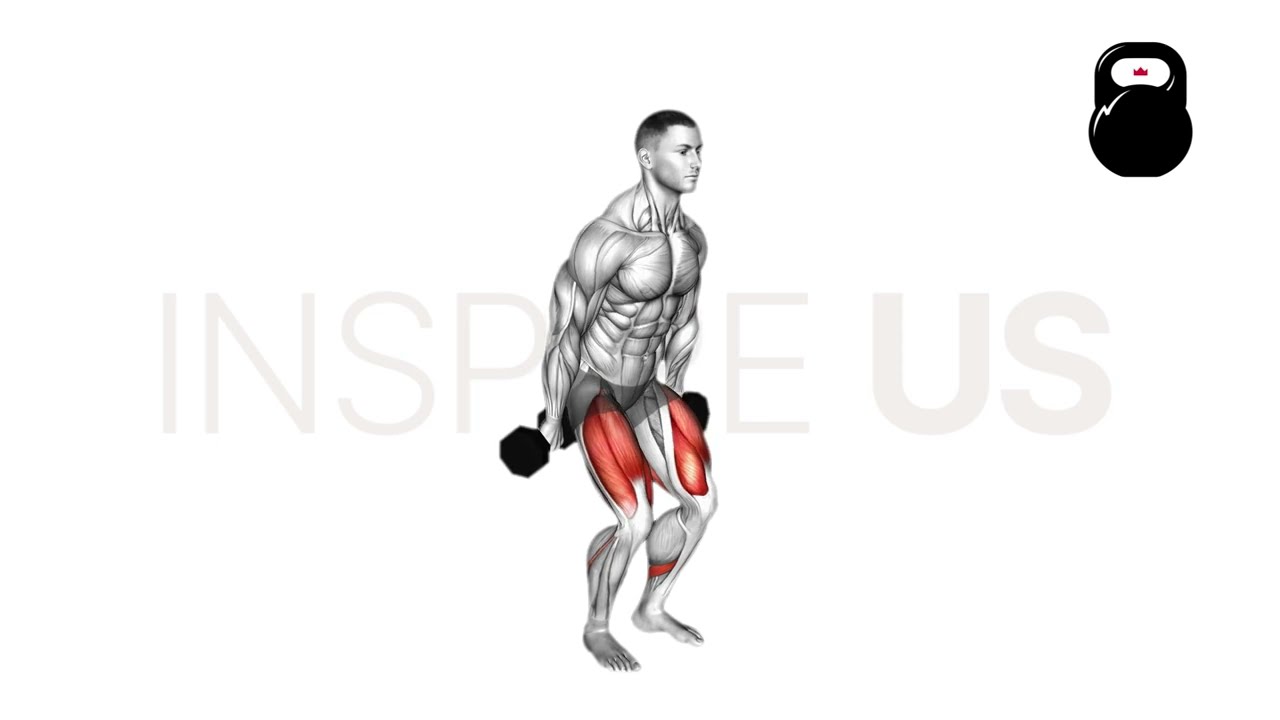Dumbbell Hack Squat: Benefits, Muscles Worked, and More
The dumbbell hack squat is a multi-joint multi-muscle lower body exercise with the usual characteristics of a closed kinetic chain movement.
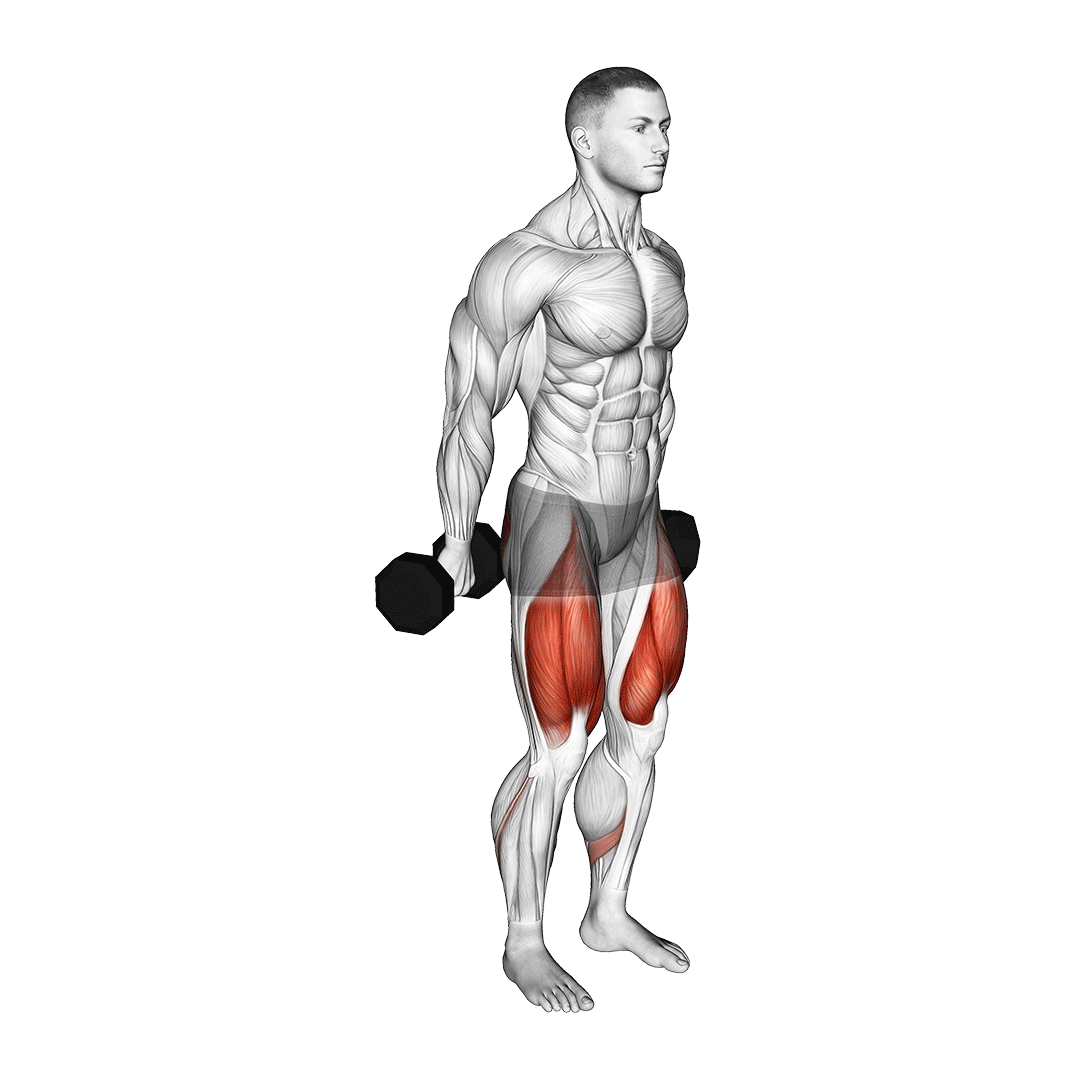
The dumbbell hack squat emphasizes the muscles of the quadriceps femoris due to the more forward leaning stance in which it is performed. Like the machine variation of hack squat, this will require the feet to be at a certain angle of incline - often with the heels themselves being elevated.
Dumbbell hack squats are performed as either a less equipment-intensive alternative to machine hack squats, or as a method of maximizing quadriceps engagement with a bilateral and moderate weight exercise.
How to Do a Dumbbell Hack Squat
In order to prepare for a set of dumbbell hack squats, the lifter will first position themselves by placing an object approximately 1-2 inches off the ground beneath their heels. A pair of moderate weight dumbbells should be held in their hands at their sides - or in a goblet grip at chest-level.
Bracing the core, facing the head forwards, keeping the spine neutral and the toes pointing slightly outwards, the lifter is now ready to perform a dumbbell hack squat repetition.
This is done by pushing the pelvis back and bending at the knees, being mindful of the body’s weight as it shifts slightly forwards due to the elevation of the heels. Ensure the knees do not track too far forwards.
Once reaching the appropriate depth (generally hamstrings close to calves), the lifter drives through their heels and rises back into a standing position. This marks the completion of one repetition.
What Muscles are Worked by Dumbbell Hack Squats?
Dumbbell hack squats are a compound exercise. In short, this means that more than a single muscle group is worked throughout its movement pattern - with these various muscles being divided according to their type of contraction.
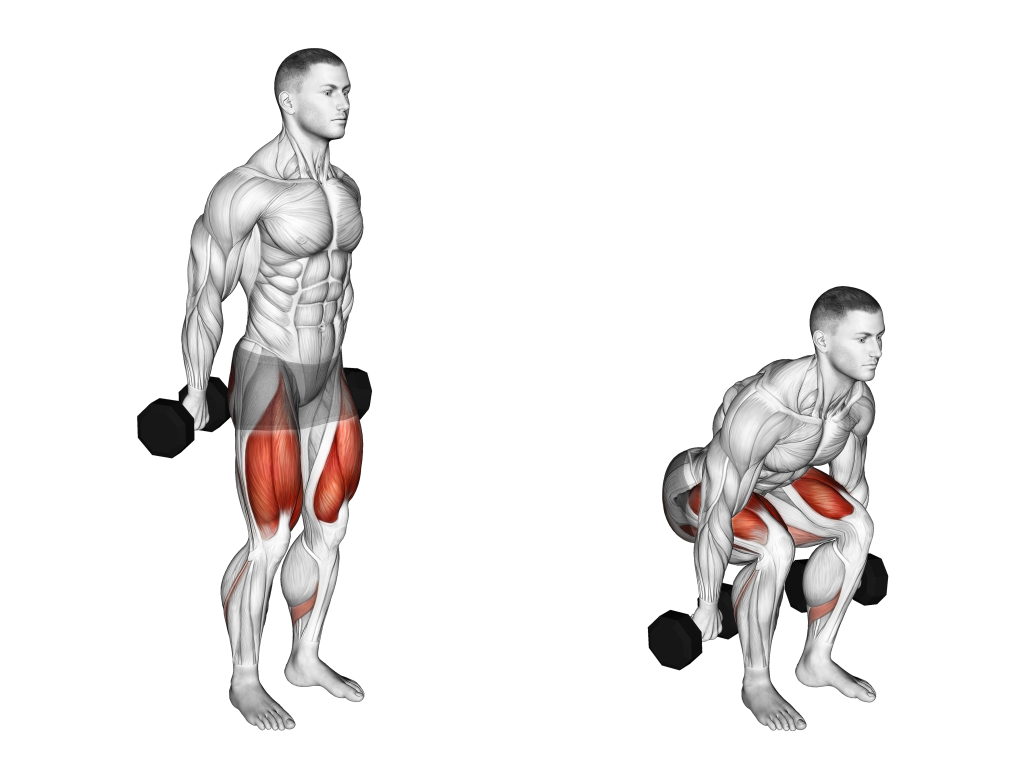
For dynamic muscular contraction, these muscles are called “mobilizer” or “mover” muscles, whereas isometric or static contraction signifies a “stabilizer” muscle.
Mover Muscles
Dumbbell hack squats prioritize the quadriceps femoris above all, as the movement pattern revolves around knee extension to a significant level.
Of course, alongside the quads are the hamstrings and glutes - both of which act in a secondary role to the quadriceps so as to initiate knee and hip extension.
Stabilizer Muscles
Apart from the mover muscles, dumbbell hack squats also engage the erector spinae, abdominals, calves, obliques and the forearms in a static manner. The involvement of the latter muscle will depend on how thick the dumbbells are and the manner in which they are held.
What are the Benefits of Doing Dumbbell Hack Squats?
Apart from being just generally good for your lower body health and function, dumbbell hack squats also offer the following benefits.
Excellent for Challenging the Quads
Like machine or barbell hack squats, the dumbbell hack squat is a primarily quadriceps-dominant movement, meaning that the quads are responsible for bearing much of the weight of each repetition. This is most present in the latter half of the repetition as the body distributes load from the hips to the knees.
Although regular squats also target the quads during a similar point in their movement pattern, the fact that the heels are elevated further distributes the weight in this manner - forcing the quads to work harder to get the knees back into a state of full extension.
Of course, there are plenty of other ways to isolate the quadriceps to an effective degree. However, few do so in a bilateral manner or with the accessibility of a dumbbell hack squat.
Alternative to Back Squats for Rising Heels
Although only a temporary solution, lifters who find themselves unable to perform back squats correctly due to their heels rising can substitute with the dumbbell hack squat.
In most instances, this mistake in squat form is a result of poor mobility of the ankles - specifically those connecting the soleus and gastrocnemius to the foot at the rear of the ankle itself.
As one can likely guess, elevating the heels (such as with a dumbbell hack squat) allows these tendons to remain in a relatively shortened state, reducing mobility demands and allowing the lifter to still train their lower body without risking injury.
Of course, it is still a smarter choice to simply improve ankle mobility rather than working around the issue. Try static ankle stretches that target the achilles tendon.
Reinforces Knee Extension Biomechanics
Because the dumbbell hack squat emphasizes the quadriceps and requires greater focus on proper knee mechanics, lifters who regularly perform the exercise will find knee extension to be smoother and more stable.
Apart from the quadriceps themselves becoming stronger, the stress placed on the tendons of the knees will improve tissue density and their capacity to withstand weight while in dynamic motion.
Can Correct Poor Weight Distribution in Other Squat Variations
Lifters new to heavy free weight squats may have difficulty correctly distributing the total load throughout their body. This can cause poor torso orientation, hunching shoulders, poor back curvature or even a loss of balance in certain cases.
Dumbbell hack squats help teach the lifter how to consciously distribute weight throughout their lower body.
Because the heels are elevated higher than the toes, the lifter will need to be mindful of how their hips and knees bear the load and translate it into the feet - all without risking serious injury by lifting large amounts of weight.
Acts as a Hack Squat Machine Substitute
Finally, the most common reason why the dumbbell hack squat is performed is simply because no hack squat machine is present.
Home gym owners, lifters in busy gyms or those that find the self-stabilizing nature of machine exercises insufficient can all substitute the machine hack squat with its dumbbell counterpart. In terms of which muscles are emphasized and general exercise mechanics, the two are similar enough to be interchangeable.
Common Dumbbell Hack Squat Mistakes
Although the dumbbell hack squat is quite a safe exercise, the following mistakes should be avoided to help you keep your balance and avoid injury.
Shifting Weight Forwards
In order to prevent yourself from falling over, ensure that the pelvis is pushed backwards and the knees forwards as you descend during the first half of the movement.
The weight should be vertically distributed downwards and into the heels, with the toes bearing significantly less load. This will keep your center of gravity in the correct location, so long as you have sufficient mobility.
Knees Tracking Too Far Forwards
Although some level of forward knee tracking is essential for performing the dumbbell hack squat, avoid doing so to an excessive degree as this may lead to a breakdown in form. Aim to touch your hamstrings to the back of your calves when at maximum depth, if mobility allows.
Knees Caving Inwards/Knee Valgus
As is a mistake in practically all forms of squat, avoid allowing the knees to “knock together” or cave inwards as the exercise is performed. Depending on your stance width, some level of adduction may be present, but the knees should never point towards each other at any point.
Curving the Upper Back
To protect the spine and ensure a proper stance is held, the upper back should remain upright with no hunching of the shoulders or shoulder blades present. The head should be facing forwards with the neck kept aligned with the rest of the cervical spine.
Generally, lifters will want to keep their torso as vertical as possible during a dumbbell hack squat. This will prevent injury and help keep the exercise stable and balanced. Rounding forwards at the upper back could be a sign of poor posture or that the entire stance itself is incorrect.
Insufficient Range of Motion
For the muscles to develop as much as possible when performing dumbbell hack squats, lifters should seek to complete a full range of motion with each repetition.
At the start and end of each rep, the legs should be nearly fully locked out - and the lifter should ensure they are squatting as deep as mobility allows during the mid-point of said repetition.
Failing to fully extend back upwards will alienate parts of the quadriceps, whereas not achieving full depth can affect glute and hamstring development.
Alternatives to the Dumbbell Hack Squat
For potential substitute exercises to the dumbbell hack squat, try the following three alternatives out.
Heel Elevated Dumbbell Front Squats
The heel elevated dumbbell front squat is quite similar to the dumbbell hack squat, only featuring a more anterior position of the weight and a wider stance. This allows for greater recruitment of the hip flexor muscles, an easier time balancing and a somewhat shorter range of motion.
Depending on your specific training needs, this particular alternative is quite useful for those that have difficulty maintaining their balance during a dumbbell hack squat - or those that wish to back off their quads somewhat.
V-Squats
The v-squat is a machine hack squat variation where the feet are set wider apart, toes angled out to the sides to a greater degree.
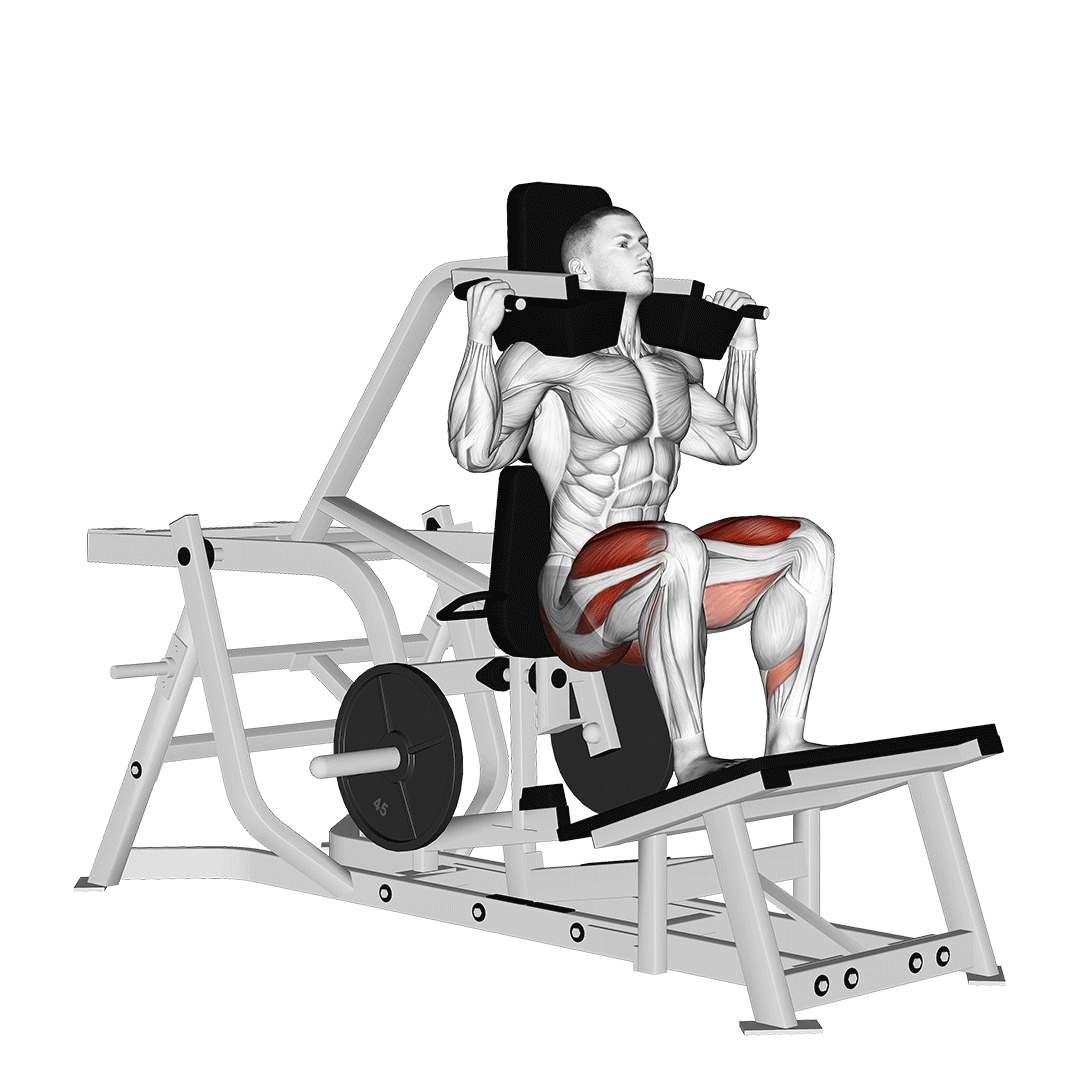
Performing machine hack squats in this manner allows for greater outward knee tracking, creating less strain on the knees and helping shift some emphasis towards muscles other than the quads.
Like the heel elevated dumbbell front squat, v-squats are ideal for those that have difficulty balancing with the dumbbell hack squat, or for those that wish to evenly target all their lower body muscles.
Barbell Hack Squats
For lifting a larger amount of weight, dumbbells can quickly become inconvenient and potentially dangerous. Substituting them for a barbell placed behind the legs can help solve this issue, as well as aid in maintaining proper torso orientation by keeping the arms tight against the sides.
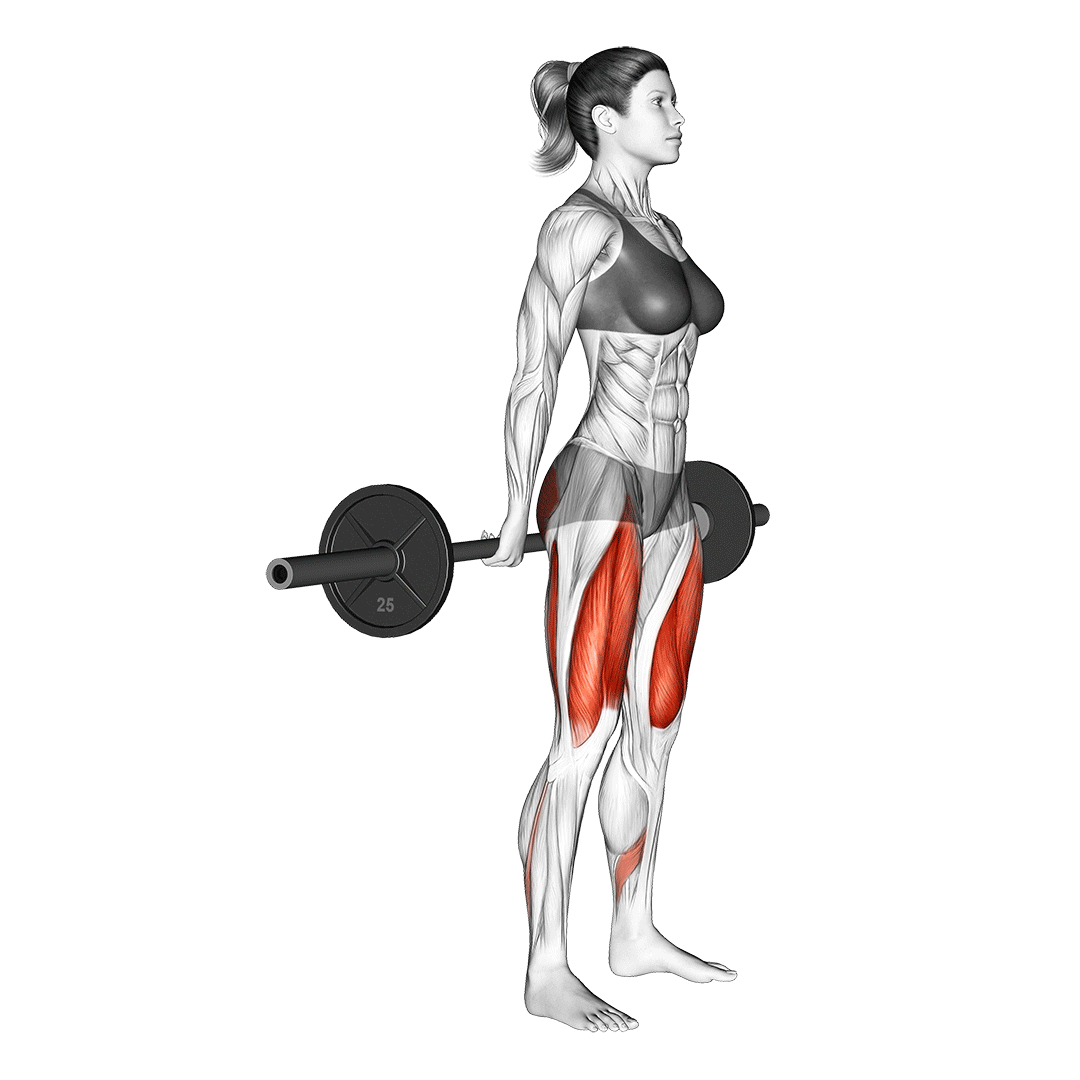
Barbell hack squats are slightly more technical than their dumbbell counterpart, but can be performed for much the same reasons nonetheless.
We suggest trying out both to see what fits best into your program.
Frequently Asked Questions (FAQ)
Is the Dumbbell Hack Squat as Effective as a Back Squat?
In certain aspects, yes. However, the back squat is somewhat more effective for targeting the glutes and hamstrings - and allows for greater amounts of weight to be lifted, to boot. Pick the right exercise according to your training needs, or perform both if possible.
Why is it Called a Hack Squat?
Hack squats are credited to George Hackenschmidt, a famous wrestler who devised the original form of hack squat as a method of training the lower body without straining the hips and back.
Can You Do Hack Squats With Back Pain?
Although you shouldn’t do any exercise without medical approval if you have back pain, hack squats are indeed comparatively easier on the spine and back. Depending on the instructions of your doctor or physical therapist, the hack squat may even be recommended so as to strengthen the muscles causing your pain.
A Few Reminders
It goes without saying that if you have a history of knee or quadriceps issues, all forms of hack squat are off the table for you. Ensure you’re fully recovered before attempting them again.
That being said - those with particularly weak (but still healthy) quadriceps may benefit from swapping out other leg exercises for the dumbbell hack squat. If you suffer from sticking points, instability or weakness after the initial push out of depth while squatting, then it is likely your quads are the issue.
Remember to adjust the elevation of your heels to meet your needs. The higher the elevation, the greater the forward tracking of your knees and the greater your quads are engaged.
References
1. Clark, Dave & Lambert, Mike & Hunter, Angus. (2017). Trunk Muscle Activation in the Back and Hack Squat at the Same Relative Loads. Journal of Strength and Conditioning Research. 33 Suppl 1. 1. 10.1519/JSC.0000000000002144.
2. Erdağ, Deniz & Yavuz, Hasan. (2020). Evaluation of Muscle Activities During Different Squat Variations Using Electromyography Signals. 10.1007/978-3-030-35249-3_114.

